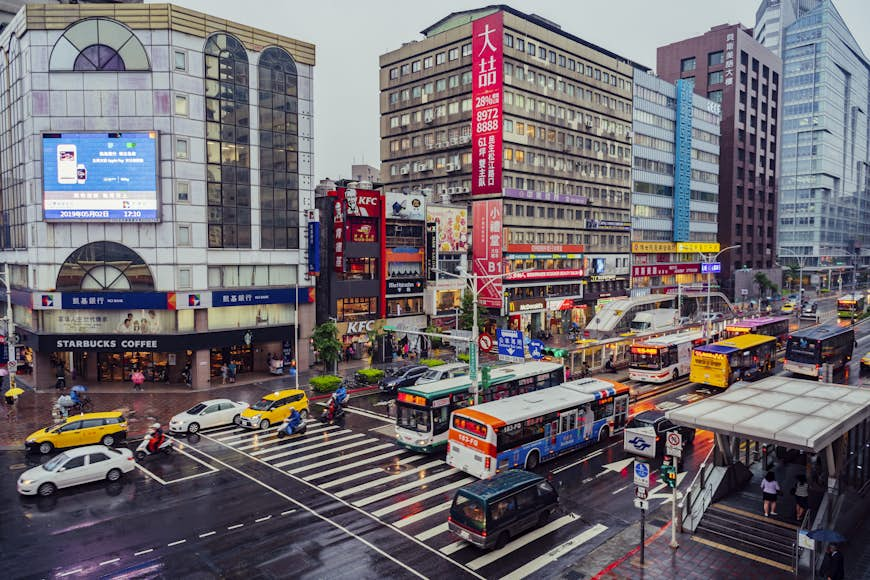
All cities and the majority of tourist sites in Taiwan are connected by a web of safe, efficient and affordable transport.
That said, there are far more options to go up and down the island than across, because of the Central Mountain Range running down the middle like a spine. If you plan on traveling all over Taiwan, be prepared to use a mix of train, high-speed rail, ferry and bus.
Steps are being taken to increase the number of electric vehicles on the road, most notably through the Blueprint for Net-Zero Emissions in 2050. Currently only 8% of city and intercity buses are electric, but the government has vowed to introduce 1000 electric buses annually from 2023 while removing up to 11,000 diesel vehicles by 2030, with the target that all buses will run on electricity by 2030. The majority of taxis are not electric, but operators are also receiving incentives to go green.
Squeeze every moment out of your next vacation with tips and tricks from Lonely Planet in our weekly newsletter delivered to your inbox.  Taiwan Railway Administration has an extensive system running along both the east and west coasts © Jui-Chi Chan / Getty Images
Taiwan Railway Administration has an extensive system running along both the east and west coasts © Jui-Chi Chan / Getty Images
Take the conventional train to the east coast
Taiwan Railway Administration (TRA) has an extensive system running along both the east and west coasts, connecting all major cities. There are no services into the Central Mountains, except tourism branch lines. Trains are comfortable, safe and reliable, with few delays.
TRA has several types of train. Zìqiáng 自強 (also Tze-chiang) express trains are fast and more expensive. All classes of Ziqiang train are priced the same for the same journey, even though, for example, the Puyuma is the fastest. Taroko Express 太魯閣 (Tàilǔgé) is a special tilting train under the Ziqiang class that takes you from Taipei to Hualien in two hours. Another tilting train under the Ziqiang class, Puyuma Express 普悠瑪 is TRA’s fastest train at 150km/h (93mph). It is named after Taiwan’s Puyuma people.
Tickets can be reserved 28 days in advance online (two more days if reserving on a Friday) or on an ibon kiosk (Chinese only), found in convenience stores and at train stations. You’ll need your passport. Early reservations are strongly advised for fast trains, especially on weekends or holidays. The hottest tickets are snapped up within minutes of release for booking at midnight.
However, most fares belong to the Jǔguāng 莒光 (also Chu-kuang) and Fùxīng 復興 (also Fu-hsing) classes. They’re comfortable, slower than Ziqiang and faster than local trains. The fare is about 20% to 40% cheaper than Zìqiang. Cheap and slow Local Train (區間車; Qūjiānchē) covers short-to-medium distances and stops at all stations. There is no reserved seating.
Use the high-speed rail to save north-south travel time
Zipping between Taipei and Kaohsiung (Zuoying station) in as fast as 90 minutes, the bullet service on Taiwan High Speed Rail (THSR) operates a single line along the west corridor that makes stops at 12 stations, including all major cities. Tickets are a little less than double the price of a standard train, but it takes less than half the time. Business fares are about 50% higher.
In general, there are at least three trains per hour. All stations have visitor information centers with English-speaking staff to help with bus transfers, hotel bookings and car rentals.
You can buy high-speed rail tickets up to 29 days in advance. It is advisable to book if you are traveling on a weekend or holiday. Early bird discounts of 10% to 35% apply when reserving a ride on non-peak-time trains five to 29 days in advance. There are tiny discounts for non-reserved tickets, which are sold only on the day of the ride.
You can reserve through the bilingual app TEXpress and pay electronically or in person, either at a convenience store or the HSR station. You can also reserve on the HSR website and pay at any HSR station or convenience store before the deadline for payment. Alternatively, you can reserve at a convenience store or directly at an HSR station. You’ll need your passport number to make reservations.
Enjoy the scenery on a sightseeing train
Besides the TRA and HSR, a handful of small-gauge branch lines are maintained for tourism purposes. Most of these are logging lines constructed by Japanese colonialists and feature vintage trains and restored Japanese-era stations.
The highly popular Alishan Forest Railway runs from Chiayi to the mountain resort of Alishan, though the final leg is still under repairs after being damaged in a typhoon. Day-trippers from Taipei like to town-hop along the Pingxi Line. The Jiji Line passes by a former logging village with a wood museum and a large kiln.
 Currently only 8% of Taiwan’s city and intercity buses are electric, but the government has vowed to introduce 1000 electric buses annually from 2023 © Getty Images / iStockphoto
Currently only 8% of Taiwan’s city and intercity buses are electric, but the government has vowed to introduce 1000 electric buses annually from 2023 © Getty Images / iStockphoto
Stretch your budget by taking an intercity bus
There’s a far-reaching network of intercity buses from Taipei to Kenting National Park and across the north as far as Yilan. Service from the west coast to the east coast is limited to a few buses a day, from Taichung across to Hualien and Kaohsiung to Taitung. Service is also limited within the east area (from Hualien to Taitung). On the west coast there are very frequent departures (some 24-hour operations), with midweek and late-evening discounts. Most companies serve the same west coast routes. The main transit points are Taipei, Taichung, Tainan and Kaohsiung.
Taiwan’s long-distance buses are reliable, comfortable and cheap. Some companies offer large, cozy reclining seats. Buses are heavily air-conditioned so pack a blanket or warm clothes. Reservations are advisable on weekends and holidays. The easiest way to buy a ticket is either from the bus station itself or from a convenience store. Most bus companies have a ticket office and stop near the main train station. Two of the biggest companies are Kuo Kuang and UBus.
Taiwan has a wide network of rural buses, but daily departures are few and far between, except to major tourist destinations. In most cases you’re better off taking the tourist shuttle buses.
Visit Sun Moon Lake on a tourist shuttle
Taiwan has an excellent system of small shuttle buses with well-planned routes that connect major and minor tourist attractions to TRA and HSR stations in 20 cities and counties, including three offshore islands. The buses usually leave hourly on weekdays and half-hourly on weekends. At the time of writing, buses are less frequent than before, but this is expected to change when tourism picks up.
 Cyclists in Taiwan are banned from national highways and expressways, but allowed on provincial, county and city highways © Shutterstock / pritsana
Cyclists in Taiwan are banned from national highways and expressways, but allowed on provincial, county and city highways © Shutterstock / pritsana
Experience Taroko Gorge on two wheels
Long-distance and recreational cycling is huge in Taiwan, and quite a lot of routes, especially in scenic tourist areas, have designated cycle lanes. The east coast is especially popular and gorgeous to cycle, so there are plenty of bike-rental places; you can also bring your bike on public transport and can carry a foldable bike (packed in a bag or case) on the HSR. For conventional TRA trains, there is more than one way to board with a bike. You’ll have no problems bringing bicycles into the country.
The cyclist’s main enemies are bus drivers and motorcyclists. Note some stretches of the east-coast highway are considered treacherous. Also keep in mind that cyclists are banned from national highways (國道) and expressways (快速道路), but allowed on provincial highways (省道), as well as county and city highways (縣道/市道).
Rent a car and chauffeur to save time
Having your own vehicle, either a car or a scooter, is particularly useful on the east coast, the offshore islands and in mountain areas. You will need an International Driver’s Permit to drive in Taiwan. And unless you have a Taiwan scooter license, scooter rental agencies often require that your international drivers license has a motorcycle or scooter endorsement.
By the standards of many countries, driving in Taiwan can be chaotic and dangerous. It is not advisable to drive in cities or medium-sized towns until you’re familiar with conditions. Parking is challenging in the big cities, but especially frustrating in Taipei. Road signage is bilingual.
It is better to charter a car to take you sightseeing. The driver will stop at major attractions to let you take pictures and walk around, or you can work out an itinerary with them.
Check the weather before booking a sailing to Lanyu Island
There are regular ferry routes to Penghu, Lanyu and Green Island (and between Lanyu and Green Island as well) in summer, and to Little Liuqiu Island year-round. Sailings to Green Island, Lanyu and Matsu are subject to weather conditions, however. Expect cancellations in bad weather and winter schedules to change frequently. There is no ferry service to Kinmen, but you can fly from Taipei or Kaohsiung.
Save air travel for trips to the outer islands
The excellent train network renders domestic air travel, except to the outer islands, a bit pointless. Domestic flights from Taipei leave from Songshan Airport and not Taoyuan. Flights to outlying islands are often canceled because of bad weather, especially on the east.
Accessible transportation
Taiwan’s train systems have made some steps towards accessibility in recent years. Almost all metro stations have elevators equipped with braille buttons, speakers, intercom and handrails. There are also waiting areas for wheelchair passengers, and tactile tiles installed on platforms and near stairs. The HSR and TRA have elevators and barrier-free seating in designated carriages. All three systems have staff to help disabled passengers should they need it.
Buses are slightly less convenientl. Only a fraction of intercity buses are barrier-free, although within big cities like Kaohsiung and Taipei, bus-drivers will let down a ramp for elderly passengers or wheelchair users. Once on board, there’s priority seating and wheelchair parking space. You can contact the Taiwan Access for All Association for assistance.
Service dogs are allowed on board system-wide. For more online resources for accessible travel, visit Lonely Planet’s Accessible Travel Portal.
Pay for public transit with an EasyCard
EasyCard is Taiwan’s contactless smart card that you use to pay for your ride on the metro and city buses. The card itself costs NT$100 and you can top up at any metro station or convenience store.
EasyCard can be used on some intercity buses and taxis, plus the majority of TRA trains. Exceptions to the latter include the Puyuma Express, the Taroko Express, and tourism trains. Passengers paying with the EasyCard get 10% off for train journeys under 70km (43 miles).



